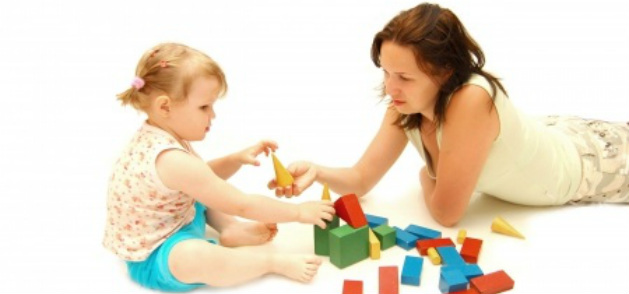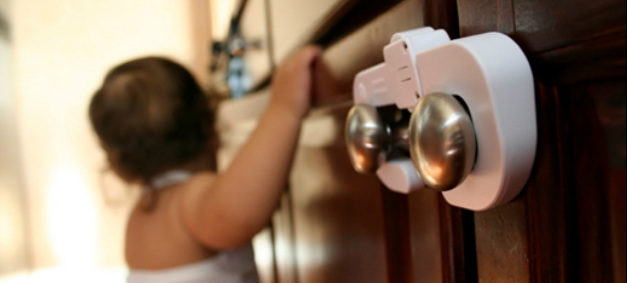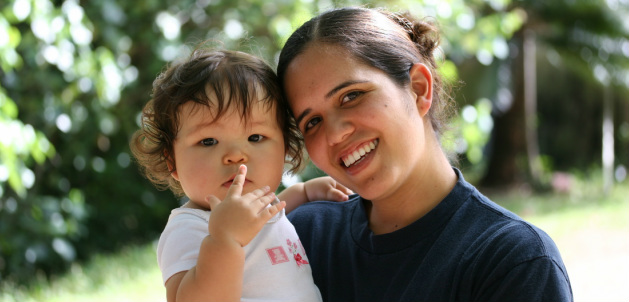|
The first few months of your baby's life can be exhausting for both parent and child. Thankfully, most babies develop regular sleep patterns by the time they are 3 to 6 months old. In the meantime, try these tips for getting your little one to sleep through the night. Getting Immediate Relief
Transitioning to Sleeping through the Night
Establishing a Successful Routine
Text adapted from Wikihow.
0 Comments
Babies are one of nature's most perfect learning machines. With just a little insight, a baby can be stimulated and kept content. Starting early in your baby's development can do wonders for their mental growth in later years, and give them a large head start over other kids their age.
Tips and Warnings
Article courtesy of WikiHow.
Being a new mother, I wasn’t sure what to do with my baby girl, Arwen, for the whole day. She is an alert child, and was quite active even as a small baby. For a couple of months I would put her on my hip and take her around the house with me throughout the day, but before long that had me bored, and unfulfilled in my care of her. I was determined to ensure that my daughter would be smart and not behaviorally challenged. I read a few books on teaching children during what they call the “window of opportunity,” from ages 0-5. I was amazed to learn how parents can teach their children so many things, provided that they are consistent and use appealing methods. I began looking for materials with which to teach Arwen —flashcards, books, and other educational materials—and some materials I personally made. I started teaching Arwen when she was three months old. After my initial fervor died, and I wasn’t seeing much progress as a result of what I was teaching her, I found myself discouraged. It seemed that she wasn’t reacting to the "schooling" I was giving her. I figured that perhaps she was too young to be learning words, numbers, and other things that I was trying to teach her. However, I continued, and after a few months, I started noticing that she was responding positively to aspects of my teaching that she recognized, which I had repeated to her many times over. Then one day just before she was seven months, after having shown her flashcards for quite some time with no apparent results, I showed her the word “clap” and without me saying anything she clapped her hands. I was completely stunned. I had hoped my efforts would pay off, but actually witnessing her response was incredible, especially at such a young age. Arwen is my first child, so every new venture in her progress is a wonderful experience for me. Perhaps I won’t be in such a perpetual state of elation with my next children, but for me this sign of progress was an encouragement to keep teaching her new things. Now I try to turn everything into a learning experience. I’ve read that the best way to teach children, besides making learning fun, is to make their life a rich learning environment. And she expects me to! Every time I pass a poster or word that I have posted for her, she gets so excited and expects me to make a big deal out of it and explain it to her. Sometimes I worry that I can’t keep up with her learning capacity, but I’m willing to keep trying to the best of my ability. I’ve experimented with ways to teach her things and have started to write them down in my notebook, so as to remember them for when she’s older. Here are some teaching opportunities I’ve been taking with her daily:
With the things I teach Arwen, I try to make learning fun, so that in the future she’ll look forward to her schooling as opposed to dreading it. Sometimes, however, she is not in the mood to learn, and wants to play by herself, which is also a part of her development, so I’m cautious to not overdo, and make sure I give her times when I’m not teaching her, too. I hope these ideas can be helpful to other new moms who are maybe looking for ways to pour into their little ones while they’re still babies. Article courtesy of Motivated magazine. Used with permission.
Judy Lyden, Scripps Howard News Service
My grandson William is eight months old and standing on his own. Children are curious and will use all their senses to absorb information. William eats anything. The 24-pound tremendosaurus makes his way to his mother’s lap and opens his mouth for shoveling. If he could, he’d say, “Faster, Mom.” William would pull a tablecloth to fetch a cookie, climb into the refrigerator to peruse goodies and into closets to forage. Funny? It could be, or it could turn tragic. Young children don’t understand, and many new parents are not watchful enough. I’ve known children who drank liquid drain-clog opener and last night’s vodka punch and others who ate Mom’s deodorant. These are poisons for young children. It only takes a few seconds. Periodic safety reevaluations of all homes are advisable. Re-evaluating your home is easy when you check the council’s Web site at http://www.homesafetycouncil.org for tips.
Taken from Grow Up Reading
The developmental changes in babies from birth to 24 months are substantial and dramatic! At birth, babies rely on crying as their primary means of communicating and interacting with the world. As they grow, babies begin to use gestures, vocal and facial expressions, exclamations, babbling, and finally words to communicate with others. Good language skills help children grow into literate adults who can read and write proficiently. Parents can help babies become successful learners and readers by developing the following early literacy skills starting at birth. Oral language skills: Babies learn language in stages. During the first four months, babies are primarily on the receiving end of language. During the next four months, babies begin to initiate and imitate sounds. By eight months, a baby responds to her own name, distinguishes emotions by the tone of voice, responds to sound by making sounds and uses her voice to express joy and displeasure. By 12 months, a baby is paying increased attention to speech and responds to simple verbal commands. She is starting to use simple gestures such as waving “bye-bye” or shaking her head “no.” She babbles with inflection and uses exclamations such as “uh-oh,” and may say a few words such as “mama” and “dada.” One-year-olds can typically say six or seven words (although many speak none at all, while others might speak up to fifty) and understand close to seventy words. There is usually a five-month lag between a child’s understanding of words and his or her ability to speak them. Between 12 to 18 months, a child’s vocabulary slowly, but steadily increases. Most children’s vocabulary explodes once he or she can say about four dozen words. By the age of two, children typically learn the meaning of eight new words a day. The more parents talk and read to their baby, the more rapidly their baby’s vocabulary develops. According to early childhood experts, language skills grow faster in children whose parents use positive rather than negative feedback. Phonemic awareness: Being aware of phonemes—the smallest, unique sounds that make up words—is the basis for learning to speak and to read. Babies are quite skilled at detecting differences in sounds. This is why children are “wired” for learning multiple languages in the early years. Babies become aware of phonemes and learn to differentiate the sounds that make up speech through interactions with parents and other caregivers. Help your baby develop phonemic awareness by talking and reading to your child every day. Encourage your baby’s babbling, which helps him to learn language. At about two months, babies begin to coo, using vowel sounds like “aaah” and “oooh.” At five or six months, babies begin to practice sounds with consonants (b, d, j, m, n, and w are the most common). One-year-olds begin to combine vowel and consonant sounds into words. Comprehension: Comprehension is central to the process of reading. While comprehension is reinforced in the later years when an older toddler and preschooler can follow the pictures and text to understand the meaning of a story, it is important to talk about what is happening in the books you read aloud to your infant. According to Jim Trelease in The Read-Aloud Handbook, “Listening comprehension feeds reading comprehension.” As your baby listens to you read, point out clues about the story in the illustrations or relate a picture to something in your baby’s life. By using strategies like these, you stretch your baby’s thinking skills and encourage greater comprehension. Compiled from parenting.com
There’s nothing wrong with store-bought playthings, but here are fun, stimulating things you can do better: 1. Reinforce the “Aha!” Think of your baby as a budding scientist and watch for moments of revelation: the smile in the bath that means “Yes! I get the rubber duck when I’m in the water!” The waving arms that translate as “When Daddy makes that face, I’m going to be tickled!” Fulfill your infant’s simple expectations and share her joy at being right. 2. Hold your baby upright when he’s alert. Infants see most clearly when they’re vertical, not horizontal. So prop him up in your lap to show him new objects, and hold him up to look over your shoulder when you take him on a tour of his brand-new world. 3. Develop facial as well as verbal dialogues. Well before babies can even baby talk, you’ll see your infant attempt to replicate your facial expressions. Make different faces and watch how her interest perks up. “Listen” and respond to her expressions. 4. Rock ‘n’ roll. To satisfy your baby’s craving for motion, waltz him around the room, swing him gently to and fro, bounce him slowly up and down, sit in a swivel chair and see how he takes to a spin in your lap. 5. Encourage tasting. Think of her mouth as a sensuous space probe, gathering data about her personal cosmos. Avoiding objects too small, sharp, or grimy, let her lick that soup spoon, gum that cup, or chomp on a bread crust. 6. Read aloud. Don’t worry about “big words.” Nursery rhymes, books—the more variations in language a baby hears in his favorite voices, the more captivated he’ll be. Choose some books with lots of repetitive language, which babies like for their predictability. 7. Sing—with or without words. Forget the lyrics to your favorite lullaby? Hum it. Musical notes without all those consonants and vowels are a simpler and often more soothing form of stimulation.  Taken from Grow Up Reading (website) Emergent literacy: Use proper vocabulary when you talk to your baby. For example, say “toes” instead of “piggies.” This helps your child learn the rules of language with minimal confusion. Babies use gestures to communicate before they can talk. Encourage your baby to use simple gestures and signs (such as clapping for saying “please,” or touching their chest to say “thank you”), which can increase a baby’s understanding of language and accelerate language development. Help your baby hear the different sounds that make up words (phonemic awareness) by saying or singing nursery rhymes. Rhyming words share similar sounds—”dock” and “clock” in the classicHickory, Dickory, Dock, for example. Nursery rhymes place rhyming pairs of words in prominent positions to naturally draw a child’s attention to these sounds. By hearing pairs of rhyming words, babies begin to understand that words are made up of separate sounds, a critical reading skill. In addition to reading traditional picture books, use interactive books: books with flaps, textures, smells, and sounds to encourage exploration and stimulate your baby’s senses. Point to images on a page and name them; this helps increase vocabulary. Also talk about what is going on in the story; this helps develop comprehension skills. Use dialogic reading when you read aloud. The basic premise of dialogic reading is adults and children having a conversation about a book. Ask your baby “what” and “why” questions about the story, pause, and then answer your questions. Introducing this type of reading and questioning early will help your child become more comfortable with the process of dialogic reading when he or she is actually using words. Cognitive development: Play with toys that react, pop up, make noise or move to help your baby understand cause and effect. Between 9 to 12 months, most children will begin to play independently with toys and enjoy toys that react or make noise. Babies this age will begin exploring objects in many different ways (shaking, banging, throwing, and dropping) and begin to use objects correctly (shake a rattle, drink from a cup, listen to a phone). Play peek-a-boo games. Young babies have not developed a sense of object permanence—the understanding that unseen objects still exist. Start by hiding your face behind a blanket and then peeking out at baby. Put a scarf over your head and let your baby pull it off; hide objects underneath boxes and let your baby knock the box over to retrieve the object. Motor development: Give your baby plenty of freedom to move around on the floor. Young infants need to spend time on both their back and stomach in order to develop the muscles for the significant motor development that takes place in the first 15 months. Spending too much time in an infant swing or seat will hinder development of motor skills. Continue with lots of floor play as your child grows and begins crawling and walking. Add climbing challenges such as cushions, ramps, and tunnels to refine gross motor skills. Games that further develop hand-eye coordination and fine motor skills include building and knocking over block towers; covering and uncovering containers; taking toys apart and putting them back together again; picking up balls or objects in motion; turning knobs and pages of a book; scribbling and finger painting; and making shapes out of clay. Social and emotional development: Play finger and hand games like pat-a-cake and peek-a-boo; encourage your baby to imitate these gestures. Gesturing is a way babies communicate before talking. When you respond to your baby’s gestures, you reinforce his efforts to communicate. Sing songs with your baby. Music stimulates the cognitive and emotional areas of the brain. Encourage dramatic play through imitation of your actions in everyday activities—household chores, hobbies, entertaining, etc. Tell your baby what you are doing and prompt him to imitate you. Pretend play helps refine motor skills and foster a sense of accomplishment. Read books about daily routines such as brushing teeth, washing hands, putting on shoes, and taking a bath. These books encourage children as they prepare to learn and master these actions. Do you have a baby, or is a baby about to enter your life? Do you want to be better prepared for parenthood? Are you looking for practical advice to help you raise a bright and happy baby? Do you want to establish a deep and lasting bond with your child?
Keys to Baby opens the door to that world of wonder and mystery that Baby lives in. Discover the amazing person your baby is and can become through love, understanding and guidance. Suzanne Schlosberg
1. “Would you please take off this sweater?” Just because the air is a tad brisk outside doesn’t mean your baby needs to be dressed for dogsledding in Siberia. Parents tend to overdress infants, who get cranky when they’re hot and sweaty—just like adults do. The fix: Dress your baby in the same number of layers as you’re wearing. If you’re not sure whether she’s too hot or too cold, put a warm hand on her tummy or back to gauge her body temperature. A baby’s feet, hands, or cheeks can often seem cool even when she’s comfortable. (The nape of the neck is also a good place to check if the baby is the right warmth. If it’s a bit sweaty, the baby is probably overdressed. It should be warm and dry. A sneeze doesn’t necessarily indicate that the baby is chilled.) 2. “Can’t we all just get along?” Babies don’t understand sentences such as, “I can’t believe you forgot to pay the Visa bill,” or “Why can’t you ever take out the trash without being reminded?” But they can sense when Mom and Dad are fighting—and they don’t like it. If there’s tension or raised voices, a baby can pick up on that and may become fussy. The fix: Occasional arguments with your husband will happen (especially given the intense demands of caring for a baby). But try to express your feelings calmly so that you create a consistent, soothing environment. 3. “I’m totally stressed out!” Too much noise, movement, or bright light—at the mall, a crowded coffee shop, or a family party—can drive a baby to tears. And after a point, too much stimulation of any kind—even being left in a doorway jumper for 20 minutes or surrounded by too many toys—can overwhelm her. The fix: Every child has a different breaking point, so pay close attention to how your baby handles commotion. Keep visits to busy stores short, eat at restaurants in the off-hours (when they’re quieter), and introduce new toys—even noise-free ones—in small doses. Also schedule some quiet time after an outing so your revved-up child can settle down. (Parties or gatherings can be a difficult environment for babies to deal with, particularly if they’re not able to go to sleep at their usual time. The noise and the activity can be overstimulating for them, or tire them out quicker than usual.) 4. “My tummy hurts!” There’s no shortage of reasons why your baby might have stomach discomfort. He could have a painful buildup of gas. He might be constipated. Formula-fed babies can develop milk sensitivity or a milk allergy, both of which can cause cramps along with mucous poop. Or your child could have reflux, in which food contents from the stomach splash back into the esophagus. The fix: First try burping your baby more often and position him upright after meals. You can also reduce gas by massaging his tummy gently or pedaling his legs. If you’re nursing, try using one breast for the entire feed instead of switching. The milk that comes out first is higher in lactose than the “hind milk” that follows. For bottle-fed babies, switch to a low-flow nipple so your child swallows less air when he drinks. Don’t panic if your baby spits up on occasion, but ask your doctor about gastroesophageal reflux disease (GERD) if the symptoms become chronic or your child seems in distress. 5. “Ouch, I’m being pinched!” Your baby could have a hair or a loose thread wrapped around her toe or finger, cutting off the circulation and causing pain and swelling. It’s more common than many parents realize. Other possibilities: Your baby’s skin is irritated by a label or a zipper, or the car-seat belt or stroller straps are chafing her. The fix: Undress your baby, and inspect her toes and fingers. If you find a hair, try unwrapping it, or cutting it with little scissors. If you have a boy, keep in mind that a hair can even get wrapped around the penis. Also check zippers and adjust any too-tight straps. 6. “I’m feeling lonely over here.” Between 6 and 9 months, your baby will learn that he’s a separate being from you, which is good. But he may start to cry as soon as you leave the room because he misses you. Which is good—and bad. The fix: If you notice a momentary separation is triggering a meltdown, stop what you’re doing and show him a little love. Sometimes just seeing you or being cuddled will stop the tears. A gentle massage or some light pats on the back will also help reassure him that when you go away, you’ll always come back. 7. “I’m starving!” Your baby just ate an hour ago, so you’re sure it’s not time for another meal. Or is it? If she’s going through a growth spurt, her tears might mean, “Waitress, I’d like another course.” These spurts typically occur at 2, 3, and 6 weeks, and at 3 and 6 months, and they last about two days. Still, babies don’t tend to check their calendar, so one might happen at any time. The fix: Is your baby really hungry? The best test is to put her in the stroller or a sling and go for a walk. If she falls asleep or calms down quickly, she doesn’t need food. But if she screams her way around the block, offer her a breast or a bottle. Don’t worry—it’s really not possible to overfeed a breastfed baby. 8. “This wall I’m staring at is getting a little old.” Spending an hour in the same chair in the same corner of the same room is the baby equivalent of being confined to an office cubicle all day: not a lot of fun. Although some infants have a higher tolerance than others for staying in one place, all babies get bored and appreciate a change of scenery. The fix: Encourage your child’s natural love of exploration by moving him to another room, taking him to the park, or running some errands together. Don’t have time to wander? Simply talking and interacting with him is a great antidote for boredom. Babies are very social. They love being around you, listening to you, and learning from you. By Chalsey Dooley It was just a little thing, that smile on my baby's face, but it changed my perspective on life. As he woke and looked up at me, he was looking at what mattered most in the world to him—me! He didn't care that his diaper needed changing or that I was dressed in mismatched pajamas, my hair a mess. He just loved me and loved being with me. He didn't need perfection; love made it all right. That moment of holding him and taking in those rays of love clarified something I'd been thinking about earlier. The lack of perfection in life has always rubbed me the wrong way. When someone said or did something that irked me, I'd often argue my case against it in my mind. Why do there have to be things like personality clashes, carelessness, inconsideration, injustice, pessimism, putdowns? These things are real, and they are wrong! I wish these things wouldn't exist. If everyone, myself included, could just get their act together, my life could be one of blissful perfection. Perfection, I reasoned, was the only thing that could ever relieve my irritations. But I also knew that could never be. This was real life. I needed another option. The more I thought about it, the more I realized that what I really wanted was for the world to revolve around me—my wishes, my feelings, my preferences, my priorities. Something had to change, and this time it had to be me, regardless of the faults of others. But how? I'd tried before. Then that morning, as I held my baby, a whisper of a thought came to me. Would you want your baby to be perfect right from the start? After pondering that thought, I couldn't imagine something I'd want less. If he'd been able to walk and run the day he was born, I'd never get to see the look of thrill and accomplishment on his face when he took his first steps, and I'd also miss that special feeling of holding him in my arms, knowing that he was completely dependent on me. If he had been able to talk perfectly from the time he was born, I'd never experience the joy of hearing him speak his first word. If he knew everything that an adult knows, I'd never get to see him overcome with wonder at some new discovery and I'd never have the fulfillment of teaching him something new. So many things I'd miss. No, his imperfection makes him just perfect. I wouldn't have him any other way! What is it then, I asked myself, that makes his imperfection different from the other imperfections around me? And the answer came. It's love. That was it! That was what I was lacking. That was what I needed more of in order to cope bravely and cheerfully when confronted by problems I wished didn't exist. Think how much you'd miss if you and everyone around you were perfect from the start. You'd miss the unpredictability of life that adds the sense of surprise; the joy of forgiving and being forgiven; the strong, abiding bonds of friendship that are formed through adversity, and the positive character traits that are formed much the same way. Adding negative thoughts to a negative situation, I realized, never brings positive results. I determined then and there to look for and find the positive opportunities and experiences that are hidden behind the mask of imperfection. When my baby couldn't sleep later that day, I decided to make the best of a difficult situation by putting my new lesson into practice. I put what I had been sure was best for him and me on hold, and my husband and I took some time to sing and laugh with him. It was a perfectly happy moment that we all would have missed had everything been "perfect" that day. Originally published in Activated Magazine. Used with permission. |
Categories
All
Archives
March 2024
LinksFree Children's Stories |









 RSS Feed
RSS Feed
